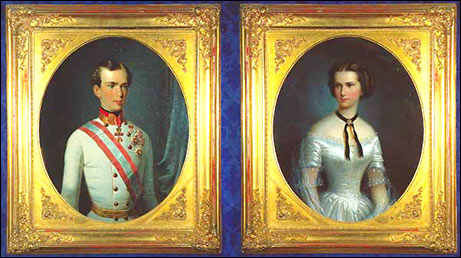![]()
The contents on this page remain on our website for informational purposes only.
Content on this page will not be reviewed or updated.
|
Elizabeth's Family
|
||
Duke Maximilian, of the House of Wittelsbach married Ludovika, a royal Princess of Bavaria and they were an eccentric family. His passions were: horses, women, music, books and the circus. He was often away pursuing these passions but they had 8 children. Max taught the girls to ride side saddle from both sides, by altering the position of the pummel, and with no stirrups. Their lives were very free in the family home at Castle Possenhoffen in the beautiful alpine countryside. Elizabeth was their third child, born on Christmas eve in 1837 and had the most skill at horsemanship as she had a great sympathetic relationship with the horses. Her elder sister, Helene (born 1834) was however the one chosen by the Archduchess Sophie and her mother as a probable wife for the new emperor. She was sufficiently intelligent and, importantly, could be obedient to Sophie. Also the Habsburgs needed to secure blood ties with Bavaria. So, a meeting was arranged in August 1853 at Bad Ischl in Austria where Ludovika took Helene and Elizabeth to meet Franz Joseph and his mother. Unfortunately the Emperor could not resist a pretty face and immediately decided that Elizabeth should be his wife. Helene would have been far better suited as she was quieter, obedient and mentally stable and the history of Europe would probably have been quite different.
The marriage was arranged for the following April 24th when Sisi (as Elizabeth had always been called) was sixteen years old and they were married in Vienna amongst great pomp and formality. He was too young, humourless and a slave to the enormous task of ruling the Habsburg empire. But as the heir to 600 years of pomp and privilege and the right to rule a vast empire he was not a suitable husband for a young girl from a free and easy background. She immediately hated the formality of court life and pined for her early life. The antipathy between her and her aunt Sophie was very great. Sophie was a slave to duty and Sisi hated all the balls, ceremony, protocol and staff that had been chosen for her household from suitable Viennese families with whom she had nothing in common. Her only escape was to the royal stables. Franz Joseph would not interfere between his mother and Sisi and felt his mother had to be obeyed. Their first child was born in 1855, a girl called Sophia. In 1856 the second was born, another girl, called Gisella. Sisi hated pregnancy and spent many hours getting back her hour-glass figure by dieting and exercise. But even the joy of motherhood was spoilt by her mother-in-law who had the children taken away so that Sisi’s undisciplined ways would not be part of their upbringing. In 1857 Franz Joseph and Sisi did go to Hungary together and she insisted that the children should accompany them. Unfortunately baby Sophia became ill and died in Buda – probably from measles or scarlet fever. In 1858 their third child was born – a boy – at last a successor for the Habsburgs. Then the Emperor had to go away to war to take command against the French in Italy. She begged to be allowed to go with him as she was suffering despair and melancholy; she felt so alone and had not the mental resources to cope. Riding was her only solace and she found a friend in Henry Holmes, an Englishman in charge of the Imperial riding horses – one of many grooms and horsemen who found employment in Austria and Hungary. Sophie disapproved and told her son but he was worn out with war and he wrote forbidding her to ride alone with Holmes. Sisi took no notice; she was wilful and he uncomprehending of her problems. After he returned in 1859 she developed strange symptoms with swellings on her wrists and ankles and a rash on her face. Doctors thought it could be TB but the rumours were that Franz Joseph had infected her with a venereal disease. It could also have been psychosomatic but she was convinced he had infected her and she fled from Vienna. Queen Victoria put the royal yacht ‘Osborne’ at her disposal and she wintered in Madeira returning to Vienna the following May 1860 where her symptoms recurred so she set off again, to the Greek island of Corfu. He followed on a state visit and she returned home in August but on her terms. She had won the battle as he knew he had wronged her and from then on could deny her nothing. Then started the travelling that was to be a constant part of her whole life. |
||
